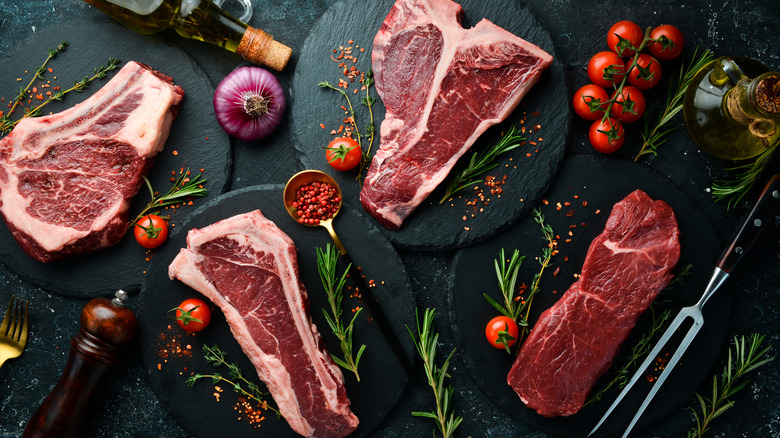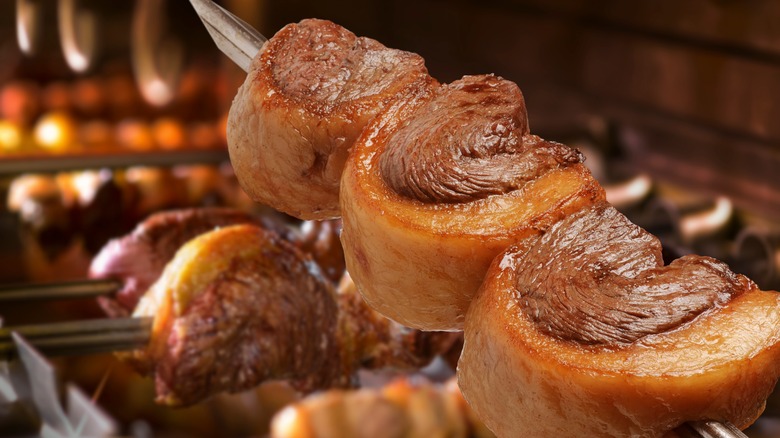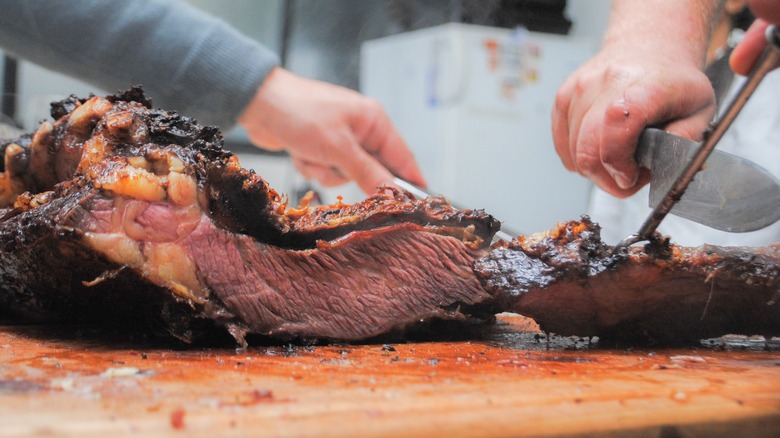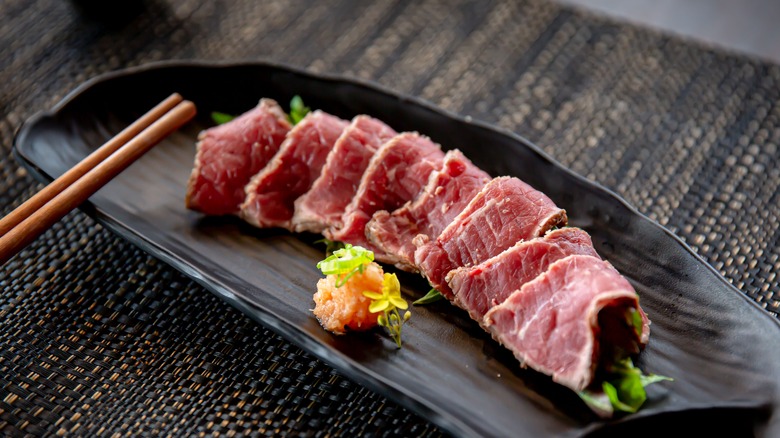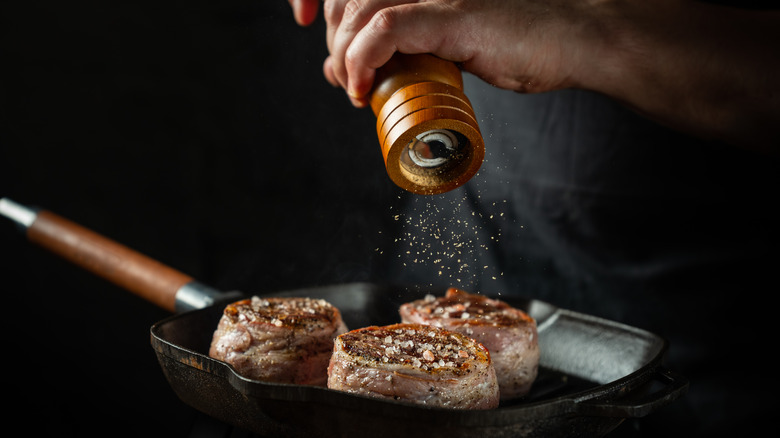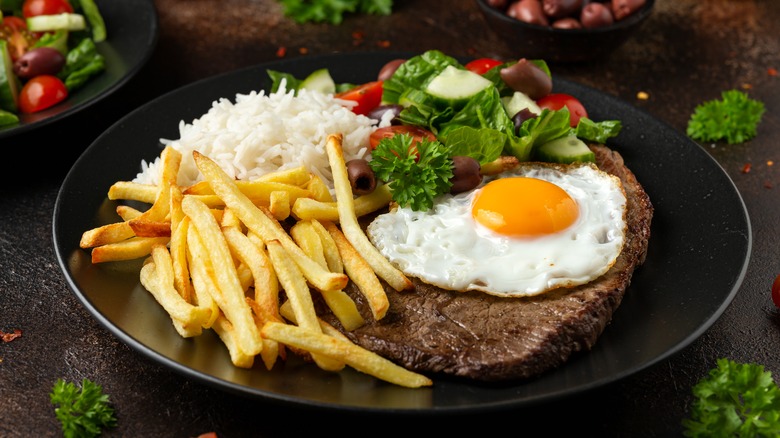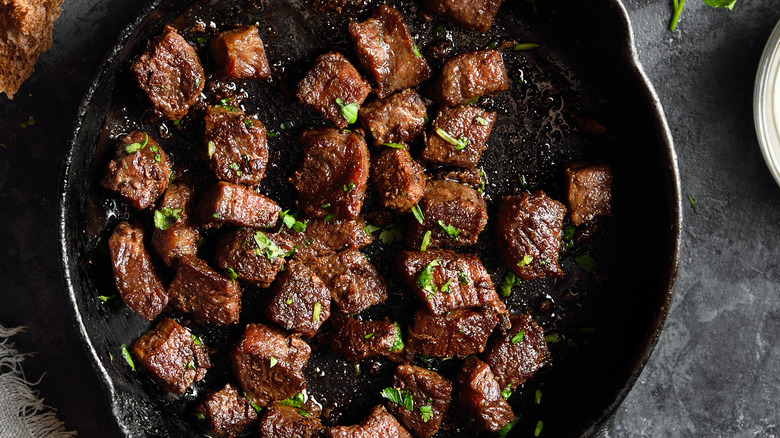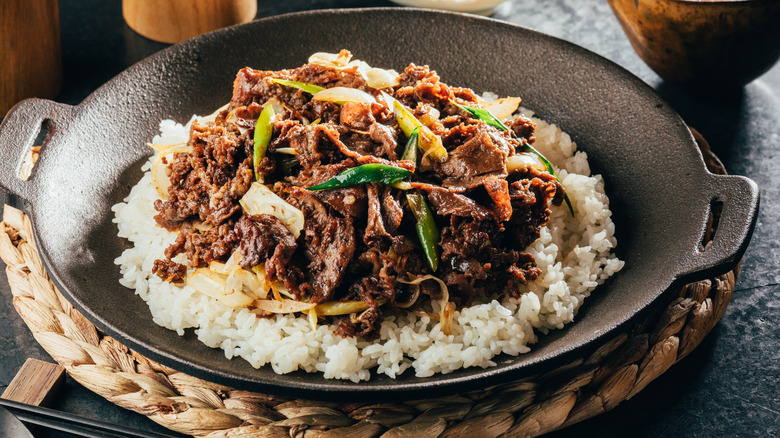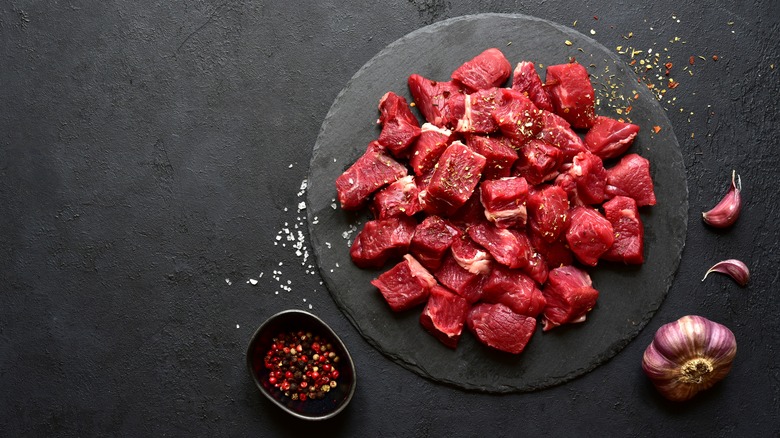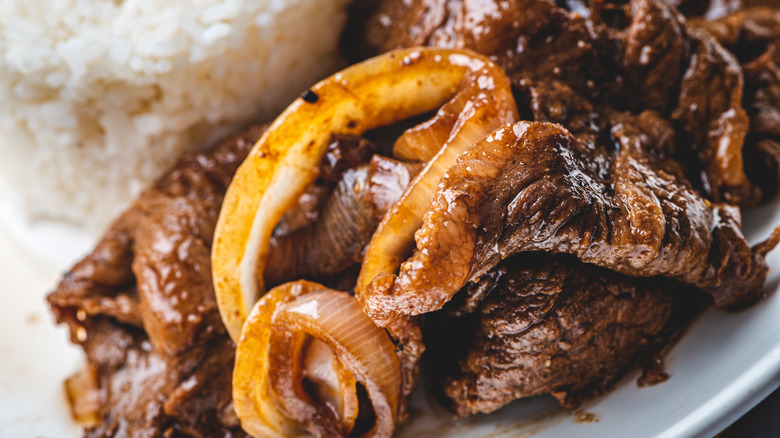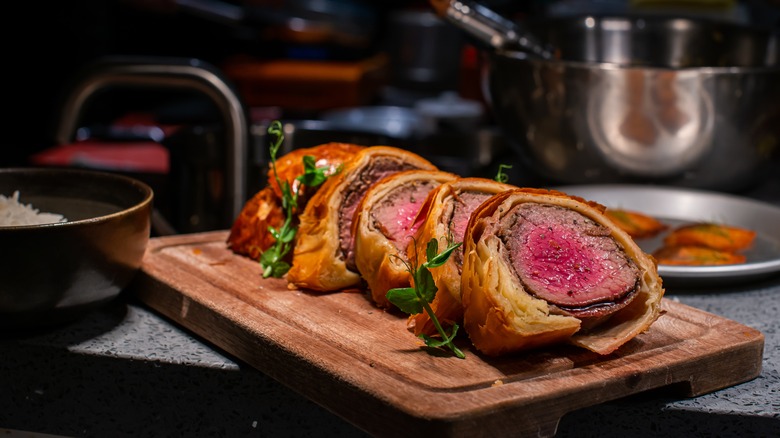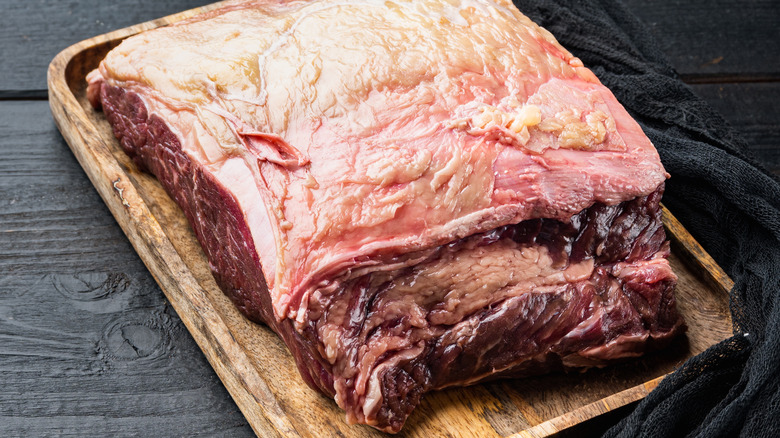11 Ways Steak Is Enjoyed Around The World
It's no secret that Americans love steak. After all, people in the United States consume an average of 264 pounds of meat per year — of which 67 are comprised of beef. And while there exist plenty of debates surrounding the nutritional merits of this popular food, most Americans agree that steak simply tastes good. In fact, in a 2023 survey conducted by Meats by Linz, it was found that 70% of Americans would consider themselves "meat lovers," while 64% would choose it for their last meal. Even vegan beef brands can't seem to ignore the deliciousness of a big, juicy slab of meat. Companies, such as Beyond Meat, have committed to working hard in their laboratories to determine the exact combination of fibers, fats, and proteins that makes steak taste so satisfying.
Even though steak remains an American favorite, this meal is hardly "as American as apple pie." Many countries across the globe, including Argentina and Brazil, report a strong cultural preference for bovine meat. Because of steak's vast popularity, there are plenty of mouth-watering preparations from across the world that could completely change your cooking game. From Brazilian churrasco de picanha to Korean beef bulgogi, these international steak cooking methods are absolutely delicious.
1. Brazil: Churrasco de picanha
No steak may be as representative of Brazil as the picanha brasileira. Not only was it voted the second-best food in the entire world by one 2023 survey, but it is also the favorite cut of steak in a country that produces 9.85 million tons of bovine meat per year. Known as "top sirloin" in English, this delicious cut of meat is most often served at a Brazilian churrasco, or "grill-out," with a generous side of rice, beans, and farofa.
Despite picanha's immense popularity, however, its origins remain murky. In an interview with the Brazilian outlet, Nossa Uol, István Wessel of the Brazilian meat company, Wessel, claimed that his family was behind the picanha brasileira craze that began in Brazil around the 1960s. "A Spaniard, Belarmino Iglesias ... told a magazine that my father was the first person he ever saw cut picanha," Wessel told the outlet. However, the Wessel family is far from being alone in their claim to picanha fame. Another Brazilian restauranteur, Fuad Zegaib, also says that he was the mastermind behind the cut's popularity. Zegaib even told Folha Vitória, "We made [picanha] in 1973. For a while, we were the only ones to offer the novelty [in our restaurant]."
Regardless of who was behind the rise of picanha brasileira, what we do know is that, during the 1950s, filet mignon was considered the best cut of meat in Brazil. Today, however, there's no doubt that picanha is king.
2. Argentina: Asado con cuero
A staple of the Argentine Pampa, asado con cuero is a cooking style that involves slaughtering a steer and then grilling its meat shortly after. The technique's name, meaning "roasted meat with leather" in English, is a reference to the fact that the steak is cooked with the skin on it. To prepare asado con cuero the traditional way, Argentine master roasters, or "asadores," start by collecting the steer's blood in order to later prepare morcilla, or blood sausage. They also remove some of the animal's organs to cook them separately. They then butcher the animal, season the meat, and let it sit overnight. As soon as dawn breaks, they throw the meat over a bed of hot coals and let it cook for 8 to 10 hours.
The history of asado con cuero dates back to the 1800s when gauchos — or Argentine cowboys — would throw huge parties following the end of the cattle market. The festivities often included the preparation of asado con cuero. While the gauchos' era has come to an end, their cooking techniques live on. Many current asadores come from families that have prepared asado con cuero over the course of generations. As José Jiménez, two-time winner of the National Asado con Cuero Festival roasting competition, told Viale, "[Asado con cuero] was something I learned when I was really young. My father was an asador. My grandfather was an asador."
3. Japan: Beef tataki
Beef tataki is a type of Japanese steak preparation that serves part of the meat raw or extremely rare. To make beef tataki, chefs start out with a tender steak, like filet mignon or a skirt steak, and marinate it in a bowl containing sake, soy sauce, garlic, and spring onions. They then quickly sear the steak on both sides so that the outer crust cooks while leaving the inside raw. Before serving their final creation, these culinary professionals slice the steak into thin pieces, displaying the beautiful ruby color of the meat's interior. Unlike other steak preparation methods, which are generally served hot, beef tataki can be placed in the fridge to cool down before the plating phase.
Interestingly, this cooking method can be applied to non-bovine steaks — a fact which may not exactly be astonishing once you consider that beef tataki was hardly the OG tataki. Legend has it that this type of meat preparation started out in the 1800s when Sakamoto Ryoma, a rebel samurai from Kochi, prepared fish tataki using local bonito. Regardless of the veracity of this tale, it remains undisputed that the most traditional version of tataki continues to be bonito tataki, and the stalls of Kochi's Hirome Market attract wide-eyed tourists who are longing to try the real deal. Even so, beef, tuna, and even swordfish tataki are popular in Japan, where foodies enjoy the fresh flavors of quickly-seared meat.
4. France: Steak au poivre
Steak au poivre, meaning "pepper steak" in English, is a French classic that involves seasoning a filet mignon with thick pieces of peppercorn and searing it in a pan with butter. Rumor has it that the meal gained popularity during the 1800s in the northern French region of Normandie, where well-known men would presumably take their dates out to dine at local bistros. Apparently, steak au poivre was the ideal food for these rendez-vous, as the peppercorns were said to be aphrodisiacs.
While it's impossible to evaluate the veracity of this story, historical evidence suggests that steak au poivre can trace its origins much further back than the 19th century. The ancient Roman cookbook "De Re Coquinaria" by Marcus Apicius makes frequent references to cooking meat with crushed — or even whole — pepper cloves. It even contains several recipes for pepper-coated steak and suggests that the reader use this seasoning as a way to mask the scent of rotting meat.
This tactic of using pepper to overwhelm powerfully-flavored meats continued well beyond the Roman era. By the 18th century, Europeans were seasoning their venison with a heavy coat of pepper to distract from the gaminess of the meat. Eventually, however, the French decided to add this crushed peppercorn to a more tender cut of beef, and the modern steak au poivre was born. These days, steak au poivre is served with a generous topping of cognac sauce, and there is even a vegetarian version.
5. Portugal: Bitoque com ovo
The Portuguese bitoque com ovo involves both steak and eggs, but it's a far cry from your typical brunch combo. This meal involves cooking a few thinly sliced pieces of topside steak on a hot pan and then serving them with a fried egg on top. Most cooks serve their bitoque in the traditional way — with a generous helping of rice and homemade french fries on the side. However, despite the general uniformity of the way that bitoque is served, there is a considerable amount of variation when it comes to the way it is dressed. Many a restaurant in Lisbon harbors its own unique recipe for a secret bitoque sauce. These sauces can include ingredients ranging from white wine to bay leaves, or even garlic.
Throughout most of Portugal, the bitoque com ovo is an extremely popular item to order in tascas, or casual local bars and eateries. Despite the ubiquitousness of this meal, however, some people believe that the bitoque's true origin lies in Galicia, a region of Spain that is located on Portugal's northern border. During the Spanish Civil War, many Galicians were forced to flee their homes; these refugees headed south to Portugal, bringing their delicious recipes along with them. Perhaps, then, the bitoque com ovo came to the land of azulejos and vinho verde from the North. However, these days, this meal is as Portuguese as, well, a torta portuguesa.
6. Gambia: Afra
If you are looking for a type of steak that also makes a scrumptious late-night snack, look no further. Afra is a Gambian street food that is most often procured in the later hours of the evening and the earliest hours of the morning. In Gambia, folks in the mood for a bite will head out to traditional dibiteries, or streetside grills, where they can not only order a serving of afra but also watch as the cook prepares it in front of them.
Afra consists of a combination of chopped meat, onions, and mustard. Customers can opt for bushmeat or lamb, but beef is also a popular choice. To prepare it, cooks fry onions in the same pan as a generous helping of steak. Cooking these two key ingredients together enhances the overall flavor of the meal by ensuring that the caramelization of the onions creates a delicious sauce for the meat. The final product is served in a paper bag so that some of the excess juices from the meat and veggies is absorbed.
In terms of sides, afra is often paired with bread and a bit of extra mustard. While baguette is a common choice, many locals opt for Gambian tapalapa bread, which resembles a combination of baguette and pretzels. You can use this bread to dip in the delicious mustard onion sauce that coats your steak. To was it down, some people really enjoy a nice thick glass of kaba juice.
7. Korea: Beef Bulgogi
An integral part of Korean BBQ culture, beef bulgogi is one of the trendiest steak preparations to be popularized internationally. For anyone who understands Korean, the food's name will sound self-explanatory. After all, bul means "fire" and gogi means "meat." The good news is that this delicious fire meat tastes as good as it sounds, and it isn't too difficult to make at home. To prepare beef bulgogi, start out by marinating a steak in a bowl filled with soy sauce, ginger, sesame oil, and other fresh veggies; then sear the meat in hot oil and serve it with pepper and soy sauce.
Although beef bulgogi has long been popular in Korea, this meal has become increasingly well-known on the world stage. Over the course of 2021, interest in Korean cuisine in general shot up dramatically, increasing by about 90%, according to a study conducted by Sooonshot (via The Food Institute). As noted by former "Master Chef" contestant Adriana Guillen, one of the forces catalyzing this Korean food craze is likely the international rise of Korean music, television, and more. As Guillen told the Food Institute, "As we become more aware of Korean entertainment, our interest in their way of life comes naturally ... and food is just the next step."
8. Tanzania: Mshakiki
If you are in the mood for a nice skewered steak, you should definitely consider making mshakiki. Mshakiki is a Tanzanian favorite that is also popular throughout much of East Africa and even parts of the Middle East. It involves chopping a piece of steak into cubes, marinating it, and then grilling it on skewers. While rump steak — or any other type of tender cut — is considered best for preparing mshakiki, you can also make this meal with tougher cuts, such as the round. Just keep in mind that the preparation time for these more collagen-heavy cuts of meat is considerably longer, as these steaks should be marinated and pounded before they hit the grill.
Home cooks who do choose to prepare mshakiki using a tougher cut should consider using fruit in the marinade. Kiwis are a particularly delicious choice, as they contain a special enzyme called actinidin, which can help tenderize your meat, per Zespri Group. Papayas can also have a similar effect, as they contain substances that break down collagen. To integrate either one of these fruits into your marinade, start out by putting your ingredient of choice into a food processor. Then, combine the puréed fruit with olive oil, apple cider vinegar, and a little bit of seasoning. For the best results, soak your cubed meat in one of these marinades overnight and then cook it the following day over charcoal.
9. Philippines: Bistek Tagalog
Served in the Philippines on special occasions, bistek Tagalog is a type of steak marinated in soy sauce, kalamasi juice, and plenty of minced garlic. Unlike many other steak preparations, bistek Tagalog doesn't need to be made with any one, specific cut of meat. Instead, the most important factor when making this delicious dinner is slicing whatever cut of meat you have available into tons of thin pieces. These slices of meat should then be marinated in kalamansi juice or lime before they are cooked in a pan via a process that's comparable to stir fry.
Similar to afra, bistek Tagalog combines the rich flavors of beef with the strong taste of fresh onions. Interestingly, however, cooks often take different approaches to how their onions are added to the meal. Some people like to fry them in the same pan as the beef, while others prefer simmering them in a separate sauce. If neither of these options sounds appealing to you, there's no need to worry — you could also consider caramelizing the onions and serving them over your meat. To make your bistek Tagalog into a delicious hearty dinner, add a generous portion of white rice, which you can use to soak up the sauce.
10. United Kingdom: Beef Wellington
Beef Wellington may have some strong French roots, but the meal became a UK classic following the end of the Napoleonic Wars. According to legend, the delicious dinner item was invented in 1815 when the first Duke of Wellington, Arthur Wellesley, defeated Napoleon Bonaparte at Waterloo. It is said that, in order to celebrate his victory, the Duke enjoyed a feast consisting of a filet mignon wrapped in a puff pastry, which was later named after him.
Although beef Wellington was served to commemorate the success of the British military, it is possible that the meal originated in France. After all, beef Wellington is so similar to the French plate, boeuf en croute, that the primary difference between these two foods is their names.
Regardless of where beef Wellington was first invented, this delightful dinner item remains extremely well-liked in the United Kingdom and beyond. British celebrity chef Gordon Ramsay has contributed to the meal's continued popularity across the globe, saying, "Beef Wellington has to be the ultimate indulgence, it's one of my all-time favorite main courses and it would definitely be on my last supper menu."
11. USA: Kansas City strip steak
When it comes to American steaks, New York strip steaks are definitely one of the most famous. However, these thick, juicy steaks aren't actually from New York, and their name didn't always reference the Big Apple. In fact, this cut of meat was initially known as the Kansas City strip steak — a reference to the place where the stockyards are — and in many parts of the country, meat lovers continue to use the cut's original name.
Kansas City strip steaks are cut from the steer's subprimal, which is just a fancy word for the short loin. And while this cut is essentially indistinguishable from the New York strip steak, some people say that Kansas City cuts will more often include the bone, while the New York version will usually omit it. Other meat aficionados insist that New York strip steaks are cut a bit thicker than their Kansas City counterparts. Regardless of how frequently these differences actually manifest, it remains undisputed that the two cuts are the same in all the ways that matter.
To enjoy a Kansas City strip steak, you can grill it, smoke it, pan-fry it, or even cook it in the air fryer. Serve it with a side of gorgonzola sauce to be drizzled over it for an even richer dish.
